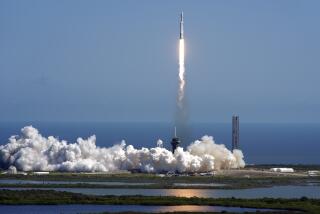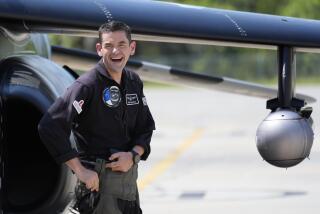Atlantis Lifts Off, Marking Shuttle’s First Decade : Space: The vehicle will deploy a unique gamma ray observatory. Two of the astronauts will test equipment in a spacewalk.
- Share via
KENNEDY SPACE CENTER, Fla. — The space shuttle Atlantis marked the conclusion of the first decade of shuttle operations Friday when it thundered into orbit to deploy a unique observatory and give astronauts their first spacewalk in more than five years.
Ten years ago next Friday, the first shuttle was launched in what many hoped would make access to space almost as routine as flying across country on a commercial airline. It did not turn out quite that way. The first decade brought many triumphs, a lot of frustration and one immense tragedy.
Atlantis is now on the 39th shuttle mission, far fewer than officials of the National Aeronautics and Space Administration had expected during the first decade. And the memory of the Challenger explosion, the greatest tragedy in the history of the U.S. space program, is especially strong every time a shuttle is launched from this sprawling facility.
Launch director Robert Sieck, who described Friday’s liftoff as “one of the best, if not the best” launching yet, admitted that the first decade did not match the “predictions or expectations” of 1981.
A space agency that had hoped to launch nearly one shuttle a week must content itself with less than once a month, he said.
Yet, spirits soared here Friday when the Atlantis found a hole in a cloudy sky and blasted off just five minutes late at 6:23 a.m. PST.
“I’m tickled pink,” said Richard H. Truly, who was a backup astronaut for the first flight and is now head of the space agency. He said the only change he would have preferred would to have been aboard the Atlantis himself.
During its five-day mission, the Atlantis will deploy the $617-million Gamma Ray Observatory, which will study gamma rays created by such violent events as exploding stars and stellar collisions. The observatory, built by TRW Inc. of Redondo Beach, Calif., is the second of four observatories that NASA hopes to have in orbit by the end of this decade. The first was the Hubble Space Telescope, which was launched with a flawed mirror that has kept it from living up to its billing of being able to see farther with greater clarity than any other telescope.
The Hubble’s problem is to be repaired during a shuttle mission in 1993, and officials are confident they will not have the same kind of problem with the Gamma Ray Observatory, also known as GRO. One reason for that optimism is that GRO has no mirror. Instead, it is four separate instruments, and the observatory will literally collect gamma rays so that scientists on the ground will be able to determine where they came from and what kind of process created them.
That, in turn, should tell them much about violent events that create gamma rays, the most energetic radiation in the universe.
The 35,000-pound observatory, the heaviest civilian satellite that the shuttle has ever carried into orbit, is to be deployed by the Atlantis on Sunday morning.
On Monday morning, astronauts Jerry L. Ross, 43, and Jay Apt, 41, will carry out the first spacewalk in more than five years. The two astronauts will test equipment that could be used by future astronauts to build the Space Station Freedom.
The Atlantis is to land at California’s Edwards Air Force Base at 6:34 a.m. Wednesday.
The commander of the flight is Steven R. Nagel, 44, and the pilot is Kenneth D. Cameron, 41. The fifth member of the crew is Linda M. Godwin, 38, a physicist who will use the shuttle’s robotic arm to deploy the observatory.
More to Read
Sign up for Essential California
The most important California stories and recommendations in your inbox every morning.
You may occasionally receive promotional content from the Los Angeles Times.










